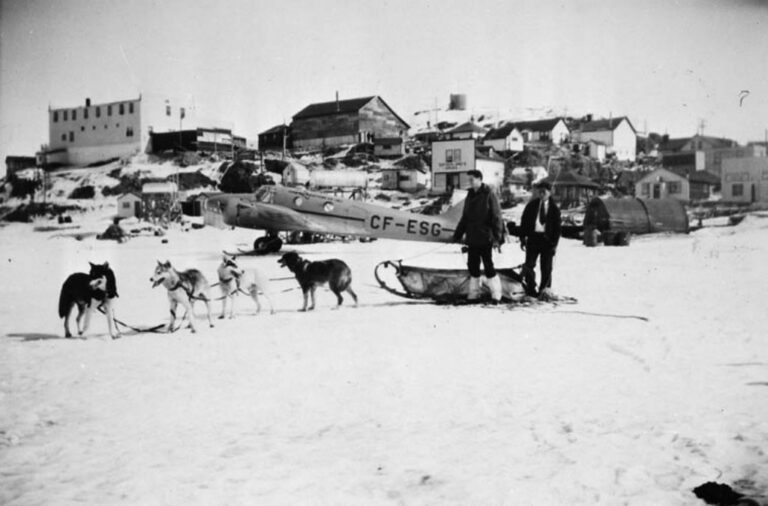Unless you grew up in Igloolik or Resolute, a quinzhee (pronounced QUIN-zee) is way easier to build than an igloo. The word itself stems from Athapaskan cultures, including the northern Dene, whose traditional ways of life are rooted deep in the subarctic snow. This kind of snow shelter — and there are many others, from drift burrows to snow castles — is made by heaping snow into a big pile then hollowing it out. Honest, that’s it. Our fluffy, thermally stratified snow around Yellowknife is the perfect building material, especially after ripening on the ground all winter.
All you need to build a quinzhee is a shovel, bucket, pot, or in a pinch, your own two hands. You’ll also need several sticks about 30 centimetres long.
Choose a site where the snow has not been previously disturbed. Trample or clear the snow from a circular area of about two to four metres in diameter, depending on how many people, dogs, kidlets, etc., you plan to accommodate. (My wife Brenda once built an eight-person quinzhee – now that I would like to have seen.) Then pile loose snow onto the circular area to make a dome-shaped mound about two meters high. Make sure the snow gets thoroughly mixed by stirring it occasionally or flinging it well into the air as you pile it. Break all blocks into fine powder and avoid any icy layers. You want a pile high and wide enough so that, when hollowed out, you can at least undress in a sitting position without touching the walls. If you want to practice your dance steps in there or hold a cello recital, well, keep piling. But keep in mind that the greater the interior volume, the longer it will take to warm up your quinzhee – from your body heat, that is.
Why the sticks? They serve as depth gauges in the quinzhee’s wall so that during the hollowing-out process you leave enough thickness for adequate insulation, at least 20 centimetres. Push the sticks two-thirds of the way into the snow pile, spacing them evenly across the surface. Some people use lots of sticks. Others pride themselves in using only a handful. Either way, it should look like a giant pin cushion when you finish this stage.
I usually leave the mound to harden for at least two to three hours. The colder it is outside and/or the longer you wait before digging it out, the harder your quinzhee will be. Unless you’re in an emergency situation, try waiting overnight to get good strong walls.
Then begin burrowing a low entrance into the pile at ground level. Keep the entrance just big enough for one person to crawl in. It’s very important to start hollowing upward as soon as you can to reduce the potentially dangerous snowload overhead. Scrape out the lower walls and floor last. When you encounter sticks, you’ll know to stop burrowing in that particular direction. Thin weak walls are dangerous and just won’t hold the heat. Besides, unintended windows serve no useful purpose in a quinzhee. If you want to get fancy, you could slip in a modest pane of lake ice to let the sunshine (or moonshine) in.
To get the greatest enjoyment from your quinzhee, build a raised sleeping platform that’s higher than the level of the entrance. This creates a kind of “cold well” in lower sections, allowing the heavier cold air to drain off. Keep about 15 centimetres of packed snow on the quinzhee floor. A caribou skin, spruce boughs or dry grass add a nice insulating touch for the pure at heart. Now is that luxury or what?
Other important finishing touches include smoothing the interior walls to avoid potential drip points, and poking a small vent hole through the top to ensure a supply of fresh air. If you’re planning to spend the night inside or are leaving the quinzhee for some time, you may want to block the entrance with a slab of snow, a chunk of plywood, or an old blanket to keep the heat in and the critters out.
A quinzhee remains at its best when the temperature is -15 C or colder and the air is relatively dry. Under these conditions, a well-built quinzhee will last you for weeks until temperatures creep above zero and that good old spring sun turns it to mush.
The quinzhee effect: how it works
A quinzhee holds together thanks to differences in the temperature and shape of snow crystals in the various layers of undisturbed snow on the ground. As you shovel snow into a pile, you’re stirring up all these different crystals.
This process of mixing and compaction dramatically increases their density and hardness by sintering, or coalesceing, different kinds of snow together. Moister, warmer layers of snow near the ground fuse with colder crystals near the surface. Once the pile has set you can dig it out to make a shelter.
Design Features: Yours for Free
• Dome shape for structural stability
• Thick walls for maximum insulation
• Vent hole for excess moist air to escape and for good oxygen circulation
• Smooth inside walls to prevent drip points
• Raised platform to take advantage of warmer air above
• Small, low entrance hole to prevent escape of warm air
• Entrance hole sheltered from prevailing wind for protection from drafts and excessive drifting







